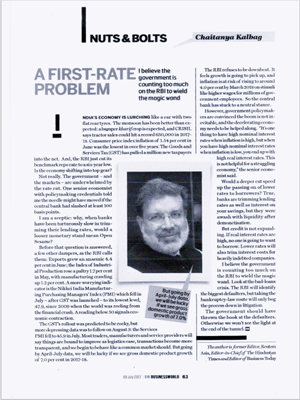A FIRST-RATE PROBLEM
[Business World]
Published date: 8 July 2017
India’s economy is lurching like a car with two flat rear tyres. The monsoon has been better than expected: a bumper kharif crop is expected, and CRISIL says tractor sales could hit a record 650,000 in 2017-18. Consumer price index inflation of 154 per cent in June was the low tin over five years: The Goods and services Tax(G T) has pulled a million new taxpayers into the net. And, the RBI just cut its benchmark repo rate to a six-year low. Is the economy shifting in to top gear?
Not really. The government- and the markets – are underwhelmed by the rate cut. One senior economist with policymaking credentials told Me the needle might have moved if the central bank had slashed at least 100 basis points.
I am a sceptic: why, when banks have been torturously slow in trimming their lending rates, would a looser monetary stand mean Open Sesame?
Before that question is answered, a few other dampers, as the RBI calls them: Exports grew an anaemic 4.4 per cent in June; the Index of Industrial Production rose a paltry l.7per cent in May, with manufacturing crawling up1.2 per cent. Amore worrying indicator is the Nikkei India Manufacturing Purchasing Managers’ Index(PMI) which fell in July – after GST was launched – to its lowet level, 47.9, since 2009 when the world was reeling from the financial crash. A reading below 50 signals economic contraction.
The GST’s rollout was predicted to be rocky, but more depressing data was to follow on August 3: the Services PMI fell to 45.9 in July. Most traders, manufacturers and service providers will say things are bound to improve as logistics ease, transactions become more transparent, and we begin to behave like a common market should. But going by April-July data, we will be lucky if we see gross domestic product growth of 7.0 per cent in 2017-18.
The RBI refuses to be downbeat. It feels growth i going to pick up, and inflation is at risk of rising to around 4.0 per cent by March 2018 on stimuli like higher wages for millions of government employees. So the central bank has stuck to a neutral stance.
However, government policymakers are convinced the boom is not inevitable, and the decelerating economy needs to be helped along. “It’s one thing to have high nominal interest rates When inflation is high, but when you have high nominal interest rates when inflation is low ,you end up with high real interest rates. This is not helpful for a struggling economy, “the senior economist said.
Would a deeper cut speed up the passing on of lower rates to borrowers? True, banks are trimming lending rates as well as interest on your savings, but they were awash with liquidity after demonetisation.
But credit is not expanding. If real interest rates are high, no one is going to want to borrow. Lower rates will also trim interest costs for heavily indebted companies.
I believe the government is counting too much on the RBI to wield the magic wand. Look at the bad-loans crisis. The RBI will identify the biggest defaulters, but taking the bankruptcy-law route will only bog the process down in litigation.
The government should have thrown the book at the defaulters. Otherwise we won’t see the light at the end of the tunnel.






